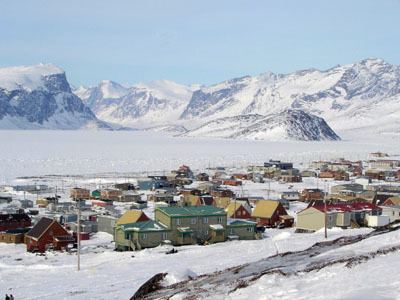Country Canada Time zone EST (UTC-5) Area 7.54 km² Population 1,481 (2016) Number of airports 1 | Electoral district Pangnirtung Canadian Postal code X0A 0R0 Elevation 23 m Local time Tuesday 9:31 PM | |
 | ||
Weather -14°C, Wind E at 21 km/h, 72% Humidity | ||
Drive through pangnirtung nunavut
Pangnirtung (or Pang, also Pangniqtuuq, in syllabics: ᐸᖕᓂᖅᑑᖅ [paŋniqtuːq]) is an Inuit hamlet, Qikiqtaaluk Region, in the Canadian territory of Nunavut, located on Baffin Island. As of the 2016 census the population was 1,481, an increase of 3.9% from the 2011 census. The area of the town is 7.77 km2 (3.00 sq mi). Pangnirtung is situated on a coastal plain at the coast of Pangnirtung Fjord, a fjord which eventually merges with Cumberland Sound. As of January 2014, the mayor is Mosesee Qappik.
Contents
- Drive through pangnirtung nunavut
- Map of Pangnirtung NU Canada
- Name
- History
- Economic development
- Harbour proposal
- References
Map of Pangnirtung, NU, Canada
Name
There is some confusion about the village name. Residents say the real name is Panniqtuuq, which means "the place of many bull caribou". Early in 2005 residents voted against officially changing the name of the village to the native one, as Pangnirtung has achieved an international reputation. Its residents have created high-quality traditional arts in sculpture, as well as adaptation of themes and design in printmaking and weaving.
Pangnirtung is nicknamed the Switzerland of the Arctic, or simply Pang.
History
The Inuit and their ancestors have inhabited the area for thousands of years, perhaps as long as 4,000. Their cultures became well-adapted to the climate and environment.
Contact with European Canadians has been limited to less than the last century. In 1921, the Hudson's Bay Company established a trading post in Pangnirtung. Two years later, the Royal Canadian Mounted Police erected a permanent office. The first government-appointed teacher arrived in 1956. The first administrative office was established in 1962.
Since then, numerous Inuit have achieved success with marketing their traditional arts. They transformed traditional drawing skills to produce lithographs and other forms of prints, allowing reproduction and wider distribution of their work. Other artists have made sculptures and carvings in local stone. Since the government established a weaving studio in 1970, many Inuit have learned to weave and are producing tapestries and other works that find an international market.
Economic development
The community operates a turbot fishery. In 2008, the federal government budgeted for the construction of a harbour.
Auyuittuq Lodge is the hamlet’s only hotel, which comprises 25 rooms, shared facilities, a dining room, and a lounge.
Power is supplied to Pangnirtung via standalone diesel generators. Fuel is imported via tanker and stored in a tank farm near the Pangnirtung airport. The purchase of diesel fuel is the responsibility of the government of Nunavut.
Water, sewage, and garbage services are provided by the municipality of Pangnirtung. Water trucks fill up at a reservoir adjacent to the hamlet and is delivered seven days a week. Sewage is pumped out and treated at the municipal treatment plant. Garbage is picked up 5 days a week and transported to a landfill that slowly deteriorates due to Arctic temperatures.
Pangnirtung is the nearest town (1 hour by boat) to Auyuittuq National Park and the location of one of two park offices, the other is in Qikiqtarjuaq. Located near to the Parks Canada office is the Angmarlik Visitor Centre. Iglunga, now uninhabited, is an Inuit hamlet to the west.
Harbour proposal
In 2009 Canadian Prime Minister Stephen Harper proposed building a new modern harbour in Pangnirtung to support the region's turbot-fishing industry. Harper received a warm welcome with many residents gathered at the airport to greet him. The town's 1,500 residents listened as Harper announced that $17 million worth of harbour construction promised in the last two budgets would get under way in the fall of that year.
Harper said the greatest potential for the hamlet's future lies in the inshore turbot fishery. The shortfalls of the current harbour are a big problem for fishermen. When the tide recedes, the harbour turns to mud.
